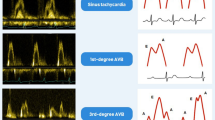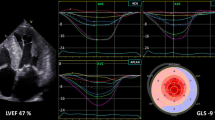Abstract
Impaired cardiac myocardial function may contribute to the risk for sudden unexpected death of a patient with epilepsy. This study aimed to investigate the effect of antiepilepsy drugs (AEDs) on cardiac function in pediatric epileptic patients using standard and tissue Doppler imaging (TDI) echocardiography. This hospital-based, prospective cross-sectional study investigated 52 epileptic children (mean age 9.3 ± 3.1 years) treated with AEDs (duration 2.4–10.0 years) and 36 healthy children (mean age 9.5 ± 4.0 years). In the epilepsy group, standard echocardiography showed increased left ventricular (LV) end-diastolic and end-systolic diameters, an increased LV mass index, and preserved ejection fraction. The patients also exhibited increased mitral peak A-wave velocity and mitral E-wave deceleration time as well as a decreased mitral E/A ratio. The E/Em ratio was significantly higher in the epilepsy group (5.6 ± 1.2) than in the control group (5.2 ± 1.1) (p = 0.016). In the epilepsy group, TDI showed an increased isovolumetric relaxation time and myocardial performance index (MPI). It also exhibited decreased early diastolic velocity (Em) and a decreased mitral annular displacement index in these patients. There were positive correlations between the LV lateral wall MPI (r = 0.231), septal MPI (r = 0.223), and LV mass index (p < 0.05) but no correlation with the duration of AED treatment. The authors detected subclinical ventricular dysfunction associated with AEDs at a preclinical stage. They suggest that TDI can be useful for determining the short- and long-term cardiac effects of AEDs.
Similar content being viewed by others
Abbreviations
- VPA:
-
Valproic acid
- CBZ:
-
Carbamazepine
- TPM:
-
Topiramate
- LTG:
-
Lamotrigine
- LEV:
-
Levetiracetam
- TDI:
-
Tissue Doppler imaging
- AED’s:
-
Antiepileptic drugs
References
Apfelbaum JD, Caravati EM, Kerns WP II, Bossart PJ, Larsen G (1995) Cardiovascular effects of carbamazepine toxicity. Ann Emerg Med 25:631–635
Arhan E, Ayçiçek S, Akaln N, Güven A, Köse G (2009) Cardiac effects of carbamazepine treatment in childhood epilepsy. Neurologist 15:268–273
Aydin K, Serdaroglu A, Okuyaz C, Bideci A, Gucuyener K (2005) Serum insulin, leptin, and neuropeptide y levels in epileptic children treated with valproate. J Child Neurol 20:848–851
Bilgi M, Yerdelen D, Cölkesen Y, Müderrisoğlu H (2013) Evaluation of left ventricular diastolic function by tissue Doppler imaging in patients with newly diagnosed and untreated primary generalized epilepsy. Seizure 24:S1059–S1311. (Epub ahead of print)
Bratton SL, Garden AL, Bohan TP, French JW, Clarke WR (1992) A child with valproic acid-associated carnitine deficiency and carnitine-responsive cardiac dysfunction. J Child Neurol 7:413–416
Cramer JA, Mintzer S, Wheless J, Mattson RH (2010) Adverse effects of antiepileptic drugs: a brief overview of important issues. Expert Rev Neurother 10:885–891
Damasceno DD, Savergnini SQ, Gomes ER et al (2013) Cardiac dysfunction in rats prone to audiogenic epileptic seizures. Seizure 22:259–266
Daniels T, Gallagher M, Tremblay G, Rodgers RL (2004) Effects of valproic acid on cardiac metabolism. Can J Physiol Pharmacol 82:927–933
Gerstner T, Woelfing C, Witsch M, Longin E, Bell N, König S (2006) Capillary microscopy and hemorheology in children during antiepileptic monotherapy with carbamazepine and valproate. Seizure 15:606–609
Hallioglu O, Okuyaz C, Mert E, Makharoblidze K (2008) Effects of antiepileptic drug therapy on heart rate variability in children with epilepsy. Epilepsy Res 79:49–54
Hatle L, Angelsan BAJ, Tromsdal A (1981) Noninvasive estimation of pulmonary artery systolic pressure with Doppler ultrasound. Br Heart J 45:157–165
Jansen K, Lagae L (2010) Cardiac changes in epilepsy. Seizure 19:455–460
Karabiber H, Sonmezgoz E, Ozerol E, Yakinci C, Otlu B, Yologlu S (2003) Effects of valproate and carbamazepine on serum levels of homocysteine, vitamin B12, and folic acid. Brain Dev 25:113–115
Kasarskis EJ, Kuo CS, Berger R, Nelson KR (1992) Carbamazepine-induced cardiac dysfunction: characterization of two distinct clinical syndromes. Arch Intern Med 152:186–191
Kjaergaard J, Iversen KK, Akkan D (2009) Predictors of right ventricular function as measured by tricuspid annular plane systolic excursion in heart failure. Cardiovasc Ultrasound 7:51
Kwon S, Lee S, Hyun M et al (2004) The potential for QT prolongation by antiepileptic drugs in children. Pediatr Neurol 30:99–101
Lang RM, Bierig M, Devereux RB et al (2005) Recommendations for chamber quantification: a report from the American Society of Echocardiography’s Guidelines and Standards Committee and the Chamber Quantification Writing Group, developed in conjunction with the European Association of Echocardiography, a branch of the European Society of Cardiology. J Am Soc Echocardiogr 18:1440–1463
Mintzer S, Skidmore CT, Abidin CJ et al (2009) Effects of antiepileptic drugs on lipids, homocysteine, and C-reactive protein. Ann Neurol 65:448–456
No authors listed (1989) Commission on classification and terminology of the International Laague Against Epilepsy: proposal for revised classification of epilepsies and epileptic syndromes. Epilepsia 30:389–399
Oki T, Tabata T, Yamada H et al (1997) Clinical application of pulsed Doppler tissue imaging for assessing abnormal left ventricular relaxation. Am J Cardiol 79:921–928
Persson H, Ericson M, Tomson T (2003) Carbamazepine affects autonomic cardiac control in patients with newly diagnosed epilepsy. Epilepsy Res 57:69–75
Roberson DA, Cui W (2009) Tissue Doppler imaging measurement of left ventricular systolic function in children: mitral annular displacement index is superior to peak velocity. J Am Soc Echocardiogr 22:376–382
Saetre E, Abdelnoor M, Amlie JP et al (2009) Cardiac function and antiepileptic drug treatment in the elderly: a comparison between lamotrigine and sustained-release carbamazepine. Epilepsia 50:1841–1849
Schwaninger M, Ringleb P, Winter R et al (1999) Elevated plasma concentrations of homocysteine in antiepileptic drug treatment. Epilepsia 40:345–350
Spina E, Kenneback G, Bergfeldt L, Tomson T (1987) Prevalence of cardiac conduction disturbances during carbamazepine treatment: preliminary data. Funct Neurol 2:563–567
Sutherland GR, Stewart MJ, Groundstroem KW, Moran CM, Fleming A, Guell-Peris FJ, Riemersma RA, Fenn LN, Fox KA, McDicken WN (1994) Color Doppler myocardial imaging: a new technique for the assessment of myocardial function. J Am Soc Echocardiogr 7:441–458
Thomas SV, Ajaykumar B, Sindhu K et al (2008) Cardiac malformations are increased in infants of mothers with epilepsy. Pediatr Cardiol 29:604–608
Tomson T, Kennebäck G (1997) Arrhythmia, heart rate variability, and antiepileptic drugs. Epilepsia 38:S48–S51
Tümer N, Yalçinkaya F, Ince E (1999) Blood pressure nomograms for children and adolescents in Turkey. Pediatr Nephrol 13:438–443
Verrotti A, Manco R, Agostinelli S, Coppola G, Chiarelli F (2010) The metabolic syndrome in overweight epileptic patients treated with valproic acid. Epilepsia 51:268–273
Walia KS, Khan EA, Ko DH, Raza SS, Khan YN (2004) Side effects of antiepileptics: a review. Pain Pract 4:194–203
Wenzelburger FW, Tan YT, Choudhary FJ (2011) Mitral annular plane systolic excursion on exercise: a simple diagnostic tool for heart failure with preserved ejection fraction. Eur J Heart Fail 13:953–960
Woodruff BK, Britton JW, Tigaran S et al (2003) Cardiac troponin levels following monitored epileptic seizures. Neurology 60:1690–1692
Conflict of interest
The authors report no conflicts of interest in this work.
Author information
Authors and Affiliations
Corresponding author
Rights and permissions
About this article
Cite this article
Kibar, A.E., Unver, O., Oflaz, M.B. et al. Effect of Antiepilepsy Drug Therapy on Ventricular Function in Children With Epilepsy: A Tissue Doppler Imaging Study. Pediatr Cardiol 35, 280–288 (2014). https://doi.org/10.1007/s00246-013-0771-8
Received:
Accepted:
Published:
Issue Date:
DOI: https://doi.org/10.1007/s00246-013-0771-8




